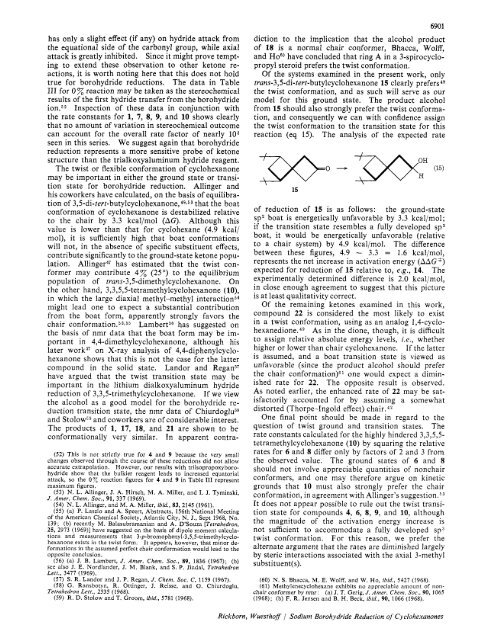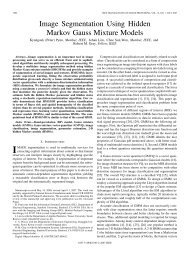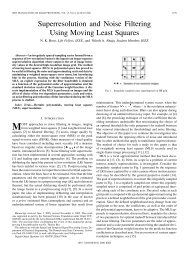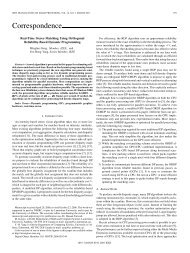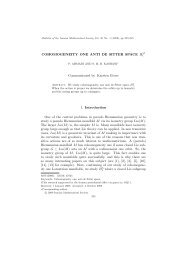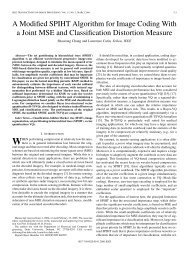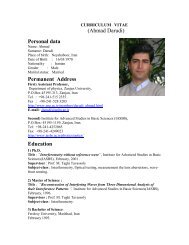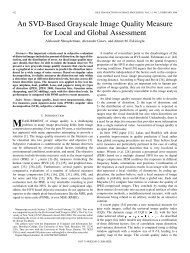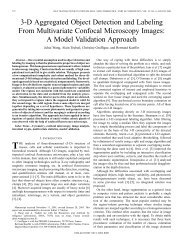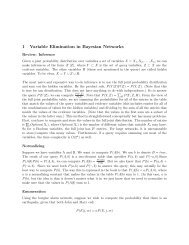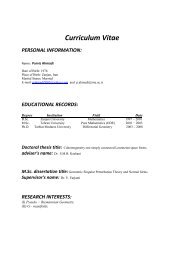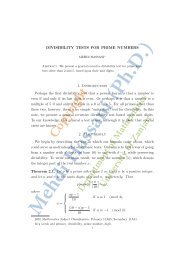1c.pdf
1c.pdf
1c.pdf
You also want an ePaper? Increase the reach of your titles
YUMPU automatically turns print PDFs into web optimized ePapers that Google loves.
has only a slight effect (if any) on hydride attack from<br />
the equational side of the carbonyl group, while axial<br />
attack is greatly inhibited. Since it might prove tempt-<br />
ing to extend these observation to other ketone re-<br />
actions, it is worth noting here that this does not hold<br />
true for borohydride reductions. The data in Table<br />
111 for 0% reaction may be taken as the stereochemical<br />
results of the first hydride transfer from the borohydride<br />
ion.52 Inspection of these data in conjunction with<br />
the rate constants for 1, 7, 8, 9, and 10 shows clearly<br />
that no amount of variation in stereochemical outcome<br />
can account for the overall rate factor of nearly lo3<br />
seen in this series. We suggest again that borohydride<br />
reduction represents a more sensitive probe of ketone<br />
structure than the trialkoxyaluminum hydride reagent.<br />
The twist or flexible conformation of cyclohexanone<br />
may be important in either the ground state or transi-<br />
tion state for borohydride reduction. Allinger and<br />
(52) This is not strictly true for 4 and 9 because the very small<br />
changes observed through the course of these reductions did not allow<br />
accurate extrapolation. However, our results with triisopropoxyborohydride<br />
show that the bulkier reagent leads to increased equatorial<br />
attack, so the 0% reaction figures for 4 and 9 in Table 111 represent<br />
maximum figures,<br />
(53) N. L. Allinger, J. A. Hirsch, M. A. Miller, and I. J. Tyminski,<br />
J. Amer. Chem. Soc., 91, 337 (1969).<br />
(54) N. L. Allinger, and M. A. Miller, ibid., 83, 2145 (1961).<br />
(55) (a) P. Laszlo and A. Speert, Abstracts, 156th National Meeting<br />
of the American Chemical Society, Atlantic City, N. J., Sept 1968, No.<br />
139; (b) recently M. Balasubramanian and A. D'Souza [Tetrahedron,<br />
25, 2973 (1969)l have suggested on the basis of dipole moment calculations<br />
and measurements that 3-p-bromophenyl-3,5,5-trimethylcyclohexanone<br />
exists in the twist form. It appears, however, that minor deformations<br />
in the assumed perfect chair conformation would lead to the<br />
opposite conclusion,<br />
(56) (a) J. B. Lambert, J. Amer. Chem. Soc., 89, 1836 (1967); (b)<br />
see also J. E. Nordlander, J. M. Blank, and S. P. Jindal, Tetrahedron<br />
Lett., 3477 (1969).<br />
(57) S. R. Landor and J. P. Regan, J. Chem. Soc. C, 1159 (1967).<br />
(58) G. Ransbotyn, R. Ottinger, J. Reisse, and G. Chiurdoglu,<br />
Tetrahedron Lett., 2535 (1968).<br />
(59) R. D. Stolow and T. Groom, ibid., 5781 (1968).<br />
6901<br />
diction to the implication that the alcohol product<br />
of 18 is a normal chair conformer, Bhacca, Wolff,<br />
and Ho60 have concluded that ring A in a 3-spirocyclopropyl<br />
steroid prefers the twist conformation.<br />
Of the systems examined in the present work, only<br />
truns-3,5-di-tert-butylcyclohexanone 15 clearly prefers49<br />
the twist conformation, and as such will serve as our<br />
model for this ground state. The product alcohol<br />
from 15 should also strongly prefer the twist conformation,<br />
and consequently we can with confidence assign<br />
the twist conformation to the transition state for this<br />
reaction (eq 15). The analysis of the expected rate<br />
15<br />
his coworkers have calculated, on the basis of equilibration<br />
of 3,5-di-tert-butylcyclohexanone, 49,53 that the boat<br />
conformation of cyclohexanone is destabilized relative<br />
of reduction of 15 is as follows: the ground-state<br />
to the chair by 3.3 kcal/mol (AG). Although this<br />
sp2 boat is energetically unfavorable by 3.3 kcal/mol;<br />
value is lower than that for cyclohexane (4.9 kcali<br />
if the transition state resembles a fully developed sp3<br />
mol), it is sufficiently high that boat conformations<br />
boat, it would be energetically unfavorable (relative<br />
will not, in the absence of specific substituent effects,<br />
to a chair system) by 4.9 kcalimol. The difference<br />
contribute significantly to the ground-state ketone popubetween<br />
these figures, 4.9 - 3.3 = 1.6 kcal/mol,<br />
lation. Allinger4' has estimated that the twist conrepresents<br />
the net increase in activation energy (AAG *)<br />
former may contribute 4z (25") to the equilibrium<br />
expected for reduction of 15 relative to, e.g., 14. The<br />
population of trans-3,5-dimethylcyclohexanone. On<br />
experimentally determined difference is 2.0 kcal/mol,<br />
the other hand, 3,3,5,5-tetramethylcyclohexanone (lo),<br />
in close enough agreement to suggest that this picture<br />
in which the large diaxial methyl-methyl interactionb4<br />
is at least qualitativity correct.<br />
might lead one to expect a substantial contribution<br />
Of the remaining ketones examined in this work,<br />
from the boat form, apparently strongly favors the<br />
compound 22 is considered the most likely to exist<br />
chair conf~rmation.~~~~~ LambertS6 has suggested on<br />
in a twist conformation, using as an analog 1,4-cyclothe<br />
basis of nmr data that the boat form may be imhe~anedione.~~<br />
As in the dione, though, it is difficult<br />
portant in 4,4-dimethylcyclohexanone, although his to assign relative absolute energy levels, i.e., whether<br />
later work37 on X-ray analysis of 4,4-diphenylcyclohigher<br />
or lower than chair cyclohexanone. If the latter<br />
hexanone shows that this is not the case for the latter<br />
is assumed, and a boat transition state is viewed as<br />
compound in the solid state. Landor and Regans7<br />
unfavorable (since the product alcohol should prefer<br />
have argued that the twist transition state may be<br />
the chair conformation)6' one would expect a diminimportant<br />
in the lithium dialkoxyaluminum hydride<br />
ished rate for 22. The opposite result is observed.<br />
reduction of 3,3,5-trimethylcyclohexanone. If we view<br />
As noted earlier, the enhanced rate of 22 may be satthe<br />
alcohol as a good model for the borohydride reisfactorily<br />
accounted for by assuming a somewhat<br />
duction transition state, the nmr data of Chi~rdoglu~~ distorted (Thorpe-Ingold effect) chair. 42<br />
and Stol~w~~ and coworkers are of considerable interest. One final point should be made in regard to the<br />
The products of 1, 17, 18, and 21 are shown to be question of twist ground and transition states. The<br />
conformationally very similar. In apparent contra- rate constants calculated for the highly hindered 3,3,5,5tetramethylcyclohexanone<br />
(10) by squaring the relative<br />
rates for 6 and 8 differ only by factors of 2 and 3 from<br />
the observed value. The ground states of 6 and 8<br />
should not involve appreciable quantities of nonchair<br />
conformers, and one may therefore argue on kinetic<br />
grounds that 10 must also strongly prefer the chair<br />
conformation, in agreement with Allinger's ~uggestion.~~<br />
It does not appear possible to rule out the twist transition<br />
state for compounds 4, 6, 8, 9, and 10, although<br />
the magnitude of the activation energy increase is<br />
not sufficient to accommodate a fully developed sp3<br />
twist conformation. For this reason, we prefer the<br />
alternate argument that the rates are diminished largely<br />
by steric interactions associated with the axial 3-methyl<br />
substituent(s).<br />
(60) N. S. Bhacca, M. E. Wolff, and W. Ho, ibid., 5427 (1968).<br />
(61) Methylenecyclohexane exhibits no appreciable amount of non-<br />
chair conformer by nmr: (a) J. T. Gerig, J. Amer. Chem. Sor., 90, 1065<br />
(1968); (b) F. R. Jensen and B. H. Beck, ibid., 90, 1066 (1968).<br />
Rickborn, Wuesthoff 1 Sodium Borohydride Reduction of Cyclohexanones


